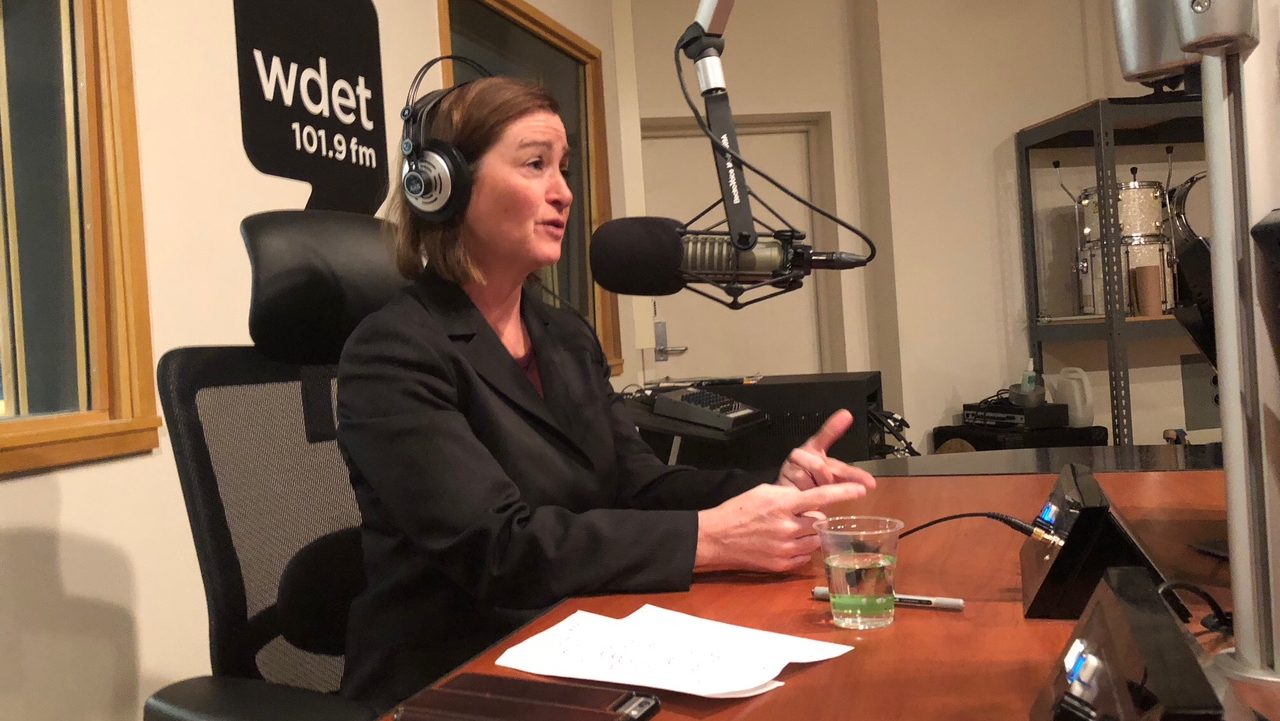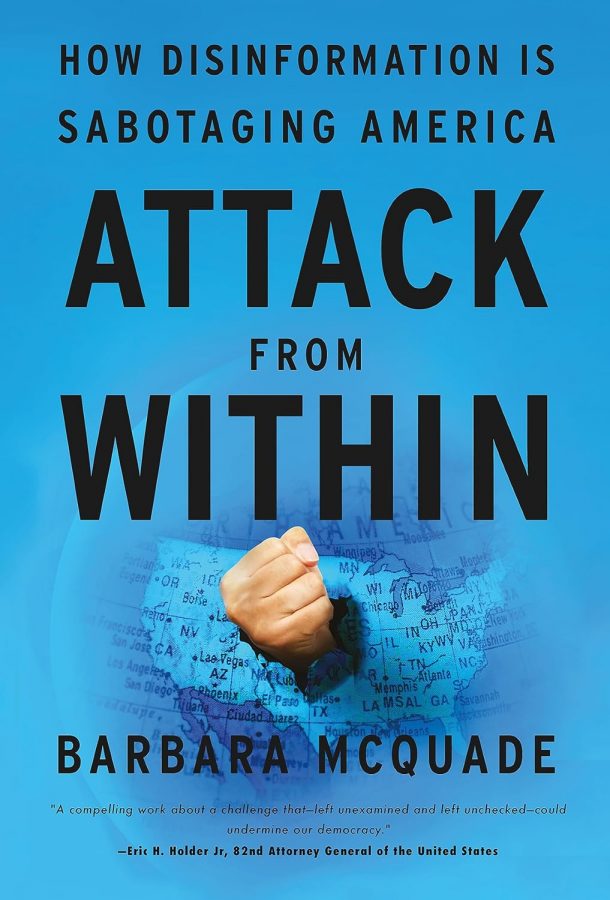Former US Attorney Barbara McQuade releases new book on fighting misinformation
Barbara McQuade sat down with WDET to discuss her book and share various ways to identify and fight the spread of misinformation.

Former U.S. Attorney General for the Eastern District of Michigan Barbara McQuade at WDET Studios.
In the age of social media, Americans face an unprecedented amount of misleading information. And former U.S. Attorney for the Eastern District of Michigan, Barbara McQuade, says the number of fraudulent stories in the public sphere continues to grow.
The University of Michigan law professor argues in her new book, “Attack from Within,” that both government and social media platforms can fight the flood of fake information in various ways — noting there are often tell-tale signs that certain stories do not reflect reality.
McQuade sat down with WDET to discuss her book and share various ways to identify and fight the spread of misinformation.
Listen: Former US Attorney Barbara McQuade releases new book on fighting misinformation
This interview has been edited for clarity and length.
On how to identify misinformation:
Anything that seems designed to upset you, there’s a decent chance that’s disinformation. And that’s because controlling one’s emotions is called reflexive control. It’s a strategy that people use to generate outrage. It keeps you on the platform. It’s something that we know from congressional testimony Facebook allows and even promotes. And it is also a way to sow division. So that which is most outrageous probably should catch your eye. When there is something that is extremely surprising news, it’s probably worth getting a second opinion.

I remember a time I fell for some false information that Patrick Mahomes had declared he would not take another snap until the Kansas City Chiefs decided to change their name to one that did not include a slur against Native Americans. I thought, ‘Wow, what a story.’ And I retweeted it right away. And then it wasn’t until later that it occurred to me to go back and see if I could find a second source for that. I couldn’t. And then when I went back and looked a little more closely, I realized that the sender had come from ESPN “Sprots” Center, not Sports center. So misspellings in names is another tell.
You can also tell when you are dealing with what is known as a bot as opposed to a real human online. There are a lot of these fake accounts generated through AI that are out there just to promote some of these false and divisive tweets or posts or whatever they are. And it makes it look like the message is more popular than it really is because it’s got a million likes. It turns out that most of those likes are actually generated by the same user through bots. There are some methods for detecting that. You can look and see that somebody doesn’t follow any other users, that’s a sign of a bot. Or they don’t have a real name, they just have some code number as their handle. If the photo is one that appears on lots of different users on the platform, that’s because it’s not a real person, it’s an AI-generated photo. There are also some tools out there that are just in their infancy to help users – “Bot finders” and other kinds of things that you can put into programs. Just as AI can be a weapon, it can also be a tool to help us detect some of these things.
On whether government should regulate social media as opposed to social media platforms regulating themselves:
I think it’s gonna take a multi-pronged approach. I do think that there’s some government regulation that’s necessary. We’ve got billionaires owning Facebook and Twitter, or “X” now, and they get to impose their own rules. Whatever they say goes based on their own philosophy or their own profit motive. That’s just not in the best interest of the public.
For example, Elon Musk likes to say that X, his social media platform, is like the town square and people can say whatever they want there. Well, it’s not. In the town square you can see who’s talking. And there aren’t robots who are repeating the message to make it look more popular. And you can tell whether people are booing or cheering or you can ignore that person and walk away. It’s anything but the town square. So I think that government regulation is necessary to some degree. I don’t know that we need government to regulate the content. But we could have government regulate the algorithms that are used to push outrage to the top of our feeds or to require transparency in who’s paying for political ads online.
I also think that consumers need to do some things. Number one, we don’t have to support platforms that we think are causing harm in society. And also the way we behave online ourselves. We could take some responsibility for having the discipline not to pass on false information, even if unwittingly, by taking the time to read not just the headline but also the story, to see if you can verify it against some other outlets. So to some extent, the power is in our own hands.
On her reaction to those who equate “fighting disinformation” with censorship:
I think that is an effort to diminish this threat. Certainly censorship is problematic in this country, to tell people what they can and cannot say. But social media companies are private actors. And if they want to have content moderation, to make their spaces safe and remove things like threats and harassment, then that is an appropriate exercise. It does not run afoul of the First Amendment. Things that are blatantly false, maybe you don’t take them down, but we can ask social media companies to include accurate information about that thing. If people say, “There’s voting fraud going on,” you can also include a link that says, “For accurate information about voting, please see this website run by the Secretary of State of the State of Michigan.”
On how to prove what is factual when someone claims to have “alternative facts” that “prove” the opposite:
I think it is a dangerous game to suggest that there’s no such thing as truth, that truth is unknowable. Maybe the great truths of the universe, like why does man exist and those kinds of things. But facts can be verified. And I think this effort to undermine confidence in truth is part of an effort like we see in the government of Vladimir Putin. And that is, there is no truth. It’s all PR, everybody lies, everybody’s corrupt. And therefore you shouldn’t believe anybody. Truth is for suckers. And what you really want is to win and you want to gain.
There’s a tactic I discussed in the book called “The either-or fallacy,” which is to promote the idea that there are only two positions on any issue and only two sides to any argument, or to politics. You’re either with us or against us. There’s no room for nuance. You must be either for the police or you must choose to defund them. And you can’t have any room for compromise. That’s where it becomes dangerous because we have politicians who demonize the opponents and tell you that they are the “other,” they are bad, they are evil. And therefore you must be on my side or else you’re part of that evil problem. This is a tactic used by authoritarians throughout history. But the way it is being used today is so toxic because the internet provides an engine to promote those theories.
Use the media player above to hear the full interview with former U.S. Attorney for the Eastern District of Michigan, Barbara McQuade.
Trusted, accurate, up-to-date.
WDET strives to make our journalism accessible to everyone. As a public media institution, we maintain our journalistic integrity through independent support from readers like you. If you value WDET as your source of news, music and conversation, please make a gift today.

